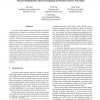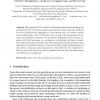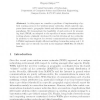ACSAC
2006
IEEE
14 years 5 months ago
2006
IEEE
In wireless sensor networks, clustering sensor nodes into small groups is an effective technique to achieve scalability, self-organization, power saving, channel access, routing, ...
ACSAC
2006
IEEE
14 years 5 months ago
2006
IEEE
Sensor networks are deployed to monitor the physical environment in public and vulnerable locations. It is not economically viable to house sensors in tamper-resilient enclosures ...
WWIC
2007
Springer
14 years 5 months ago
2007
Springer
Providing security services for wireless sensor networks plays a vital role in secure network operation especially when sensor networks are deployed in hostile areas. In order to p...
WAIM
2007
Springer
14 years 5 months ago
2007
Springer
We propose DHCS, a method of distributed, hierarchical clustering and summarization for online data analysis and mining in sensor networks. Different from the acquisition and aggre...
SSS
2007
Springer
14 years 5 months ago
2007
Springer
Abstract. In sensor networks, correct clocks have arbitrary starting offsets and nondeterministic fluctuating skews. We consider an adversary that aims at tampering with the cloc...
PACT
2007
Springer
14 years 5 months ago
2007
Springer
The application of the Orthogonal Organized Finite State Machine (OOFSM) to the representation of data acquired by sensor networks is proposed. The OOFSM was proposed in earlier wo...
OTM
2007
Springer
14 years 5 months ago
2007
Springer
Abstract. Recent contributions have uncovered the potential of network coding, i.e. algebraic mixing of multiple information flows in a network, to provide enhanced security in pa...
NEW2AN
2007
Springer
14 years 5 months ago
2007
Springer
Abstract. In this paper we consider a problem of implementing a hybrid routing protocol for wireless sensor networks, which natively supports data-centric, geographic-based and add...
MSN
2007
Springer
14 years 5 months ago
2007
Springer
The access scheduling on the control channels in TDMA wireless mesh networks is studied in this paper. The problem is to assign time-slots for each node in the network to access th...
MSN
2007
Springer
14 years 5 months ago
2007
Springer
To increase the lifespan of wireless sensor networks (WSN) and preserve the energy of sensors, data aggregation techniques are usually used. Aggregation can be seen as the process ...



